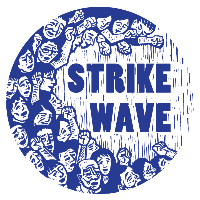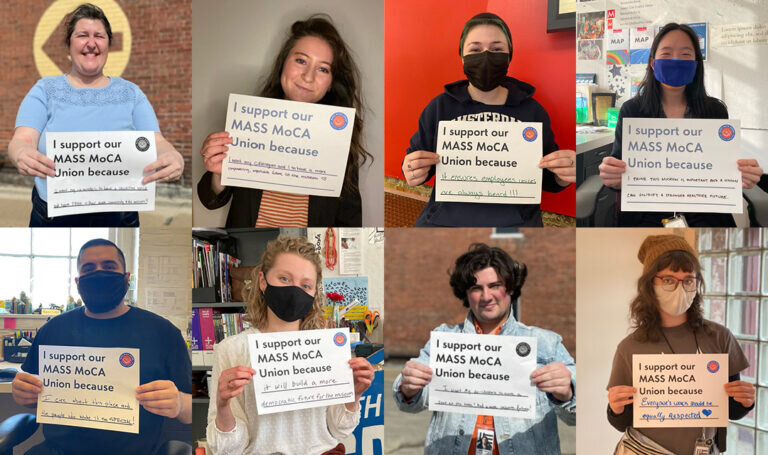"COVID revealed so many issues that were under the surface, particularly in the arts". Interview with Amanda Tobin of the MASS MoCa union.
by Sean Collins
Source: MASS MoCa Union website
Early this March, museum workers at the Massachusetts Museum of Contemporary Art (MASS MoCa) went public with their union organizing drive with UAW 2110, joining the wave of museum workers organizing across the country and in particular in the Northeast. Since the beginning of the pandemic, UAW has organized workers at the Boston Museum of Fine Arts and the Portland Museum of Art; they also represent museum workers at the New Museum and the Tenement Museum. Other workers at museums in Minneapolis, Milwaukee, Philadelphia, and Pittsburgh have organized in recent years. We spoke with Amanda Tobin, MASS MoCa’s Associate Director of Education, about what prompted the organizing drive and what issues within arts and culture institutions the pandemic has exacerbated.
Strikewave: At the beginning of the pandemic, MASS MoCA laid off over 100 staff members. There’s also been a wave of museum organizing happening across the Northeast. Was there an organizing effort underway before the pandemic or was it aggravated by the pandemic?
Amanda Tobin: Definitely by the pandemic. I had a former colleague and we used to say, “we should really organize.” But we were always very afraid of losing our jobs...and then we did. We did everything right, we followed all the rules, and it still didn’t protect us. When I was rehired after getting laid off last year — I was only unemployed for about six weeks — it was something a couple other colleagues and I started thinking - “Now’s our chance, now’s the time.” It gave us the courage to start making it happen.
SW: What about the pandemic underscored the need to organize?
AT: It demonstrated that we felt very disposable and that we were made disposable. I have been at the museum for six years at that point. I had a colleague who was there for eighteen years who was laid off (and also rehired). The confused communications throughout the beginning stages of the pandemic — we had very different messages. Different supervisors told their laid-off employees different things. Information didn’t come from Human Resources in a timely fashion, which messed up and delayed my own unemployment benefits. It all happened very suddenly, and there were no reassurances that there would be any job to come back to. In fact, it was made very clear that we shouldn’t count on that at all. There was also very opportunistic reshuffling of departments. A lot of people realized their jobs weren’t going to be there to come back to. They used it as an opportunity to ‘deal’ with people they didn’t want to deal with, and instead of honoring their service to the museum, they left them unemployed during a pandemic.
SW: Of the roughly 120 laid off out of the approximately 160 staff, how many were rehired?
AT: I don’t have exact numbers. There are about 130 of us now total, so we’re not back at our pre-COVID workforce. I’ve estimated about two-thirds of us were brought back.
SW: A lot of folks assume these museum jobs are these white collar jobs, but there is also a physical component to this work as well. You work in the Education Department, but many of your coworkers set up these exhibits. Is your union wall-to-wall, organizing all of the museum’s staff?
AT: Yes, it is. It includes folks from the administrative side, like me, other educators, grant writers, finance, and curators but also our art fabrication crew. They’re the ones up on the forklifts. They’ve raised concerns about machinery and safety. Our custodial staff are also included; they are currently on the frontline during the pandemic. Finally, our maintenance crew, who shovel snow after our many snowfalls or are involved in some of the production for the James Turrell Skyspace opening this spring, are also included.
SW: MASS MoCA often highlights its role in the economic resurgence of the Berkshires and as a centerpiece of the broader arts and culture industry of Western Massachusetts, helping reverse the impact of the region’s deindustrialization. But that’s the public facing veneer. What are these jobs actually like under normal circumstances?
AT: Like many nonprofits, many arts organizations, lots of people are there because they love the work. There’s a lot of long hours for not a lot of pay. There’s a parallel effort, Change Berkshire Culture. It’s an anonymous Instagram account, but they have a salary transparency spreadsheet going around tracking pay at Berkshire cultural nonprofits. While things have definitely improved at MASS MoCA over the years that I’ve been there in terms of salary, it's still pretty bleak for the field. I was encouraged that you heard about the layoffs. Over the summer, I saw some local teachers and they were saying, “At least we’ve got MoCA, MoCA always has jobs.” They hadn’t heard! I think people have felt there are corners cut, often in terms of safety. They try to get the most out of interns, who receive tiny stipends and are provided housing, but are often working incredible hours during the festivals.
SW: After the layoffs early last year, the museum announced a leadership transition. Was this a real change in management styles or was it mostly cosmetic?
AT: There have been real, genuine efforts from management to work on rebuilding trust and bettering the work culture at the museum. There were moments when we were organizing in the fall, some would say, “We have this transition happening, do we still need this?” We don’t want to be dependent on those folks at the top right now, spearheading these changes, because if they move on, these initiatives like a Staff Advisory Council might disappear. A union has lasting infrastructure changes that can ensure long-term benefits.
SW: With this wave of museum organizing happening across the Northeast despite the pandemic, what has the pandemic revealed about the business model of the arts? Is it sustainable in its current form? What can unionizing do to change the direction of MoCA and the broader industry?
AT: COVID revealed so many of the things that were under the surface, particularly in the arts. It exposed the pay inequities in the field. It wasn’t as egregious at MASS MoCA, but looking at these directors and high level staff who kept their jobs, and have six figure salaries, while the part time and entry level staff were let go immediately. It makes you think about what a pay cut could do to save someone’s job at this time. Across the country, with all these unionization efforts, people are saying, “this model is not working.” At MASS MoCA, I think about 60% of our revenue is earned income from ticket sales, which is pretty unusual. Long term, I’d love to see museums get a little more independent from philanthropy and board structures. We shouldn’t be so dependent on individuals and their gifts when those individuals are often very disconnected from the realities of the workers and our more high-needs audiences that many museums are trying to do better by. The community of North Adams is my primary focus in the education department. Many of the folks in our union want to see more attention to our neighbors rather than the tourists.
SW: That’s another consequence of the pandemic that our readers or tourists may not realize, the impact on various educational services museum workers like yourself provide to students, especially in a poor, working class community like North Adams.
AT: COVID has made institutions reassess what success is since we can’t have huge numbers anymore. That’s usually the marker. ‘This program had 3,000 people attend one Saturday last year, let’s try to break that next year.’ And that’s what makes it successful or not, not the quality of experience, not the depth of experience. How many New Yorkers are we getting, how many international visitors, from all across the country...now there are travel restrictions. Now the only people coming to Mass MoCA have either quarantined or are from Massachusetts. It’s an opportunity I want the museum to hold onto. Our museum does a lot. Our education department, we’re three full time staff right now — we were four before the pandemic. We’re really busy now. We provide fully subsidized school programs for twelve elementary schools and some high schools. We pay for the transportation, we pay for the admission, we provide tour guides and some arts-based experience that also touches on social justice issues, just by nature of the art we show at Mass MoCA. I’ve been intentional in crafting curricula around those exhibitions.
We also have a pretty new program, in partnership with the Massachusetts Department of Children and Families (DCF), that my colleagues oversee. About one in three North Adams children has had some contact with DCF — a huge number. So we wanted to extend the school partnership model and build capacity to reach these children. We’ve been hosting supervised visitations in our Kid Space — and more since the pandemic — about 10 every week because there are so few places for children to meet their parents indoors safely. We’re hoping to bring back Sibling Saturdays, where siblings who were placed in separate foster homes can come to the museum together. This is the thing about the funding question — grant funders love to fund new initiatives for these audiences. Not a lot of funders want to fund the overhead and salaries, but they love to fund these sort of projects.
SW: Since you all went public with your organizing effort, what has been management’s response?
AT: We filed for an election. We’re hoping they will agree to neutrality and just let the election take place. They issued a very concise statement. We got some sense that they may challenge a few of our colleagues' eligibility, including myself. I’m still pretty hopeful. All of these museum workers have been successful in their efforts, almost more so when museums have launched aggressive anti-union campaigns. We’ll see — the leadership has been very cautious. [Editorial note: Since this interview, a mail ballot election has been scheduled, with ballots sent out April 8 and due back April 28. Management has agreed to not interfere with their efforts to organize.
SW: What would you say to other museum workers or other workers in arts and culture who might be thinking about organizing right now?
AT: This is a tipping point for the field. Personally, I feel really optimistic and hopeful for the future. All of these inequities — racial inequities and class inequities — have been revealed this summer. This is a real concrete way to change the power dynamic within museums. We’ve been so thankful to our colleagues across the country for their support. The other museum unions have been amplifying our social media presence. It’s this wonderful family. I would offer to extend that to other folks who are interested in organizing, and talk to them about what it could mean for their institution. We want to pay it forward.
Sean Collins is Secretary-Treasurer of the Strikewave Board. He is a staffer with SEIU Local 200United in Upstate New York and also serves as the Treasurer for the Troy Area Labor Council, AFL-CIO.

